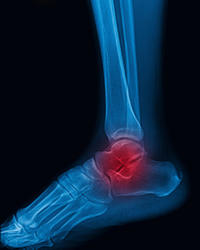From youth to high school and collegiate to pro, thousands of athletes take to the gridiron to participate in this great American past time. Unfortunately, with the coming of Fall and football, also come injuries.

I
probably speak for more than myself when I say Fall is my favorite
season. In addition to cooler temperatures and the beautiful changing
color of the leaves, Fall means FOOTBALL! From youth to high school and
collegiate to pro, thousands of athletes take to the gridiron to
participate in this great American past time. Unfortunately, with the
coming of Fall and football, also come injuries.
There is perhaps
no other sport that places a higher demand on the body as football.
While head injuries and concussions may have recently received the most
attention, injuries to the lower extremity remain the most common
football injury. In my twenty years of sports medicine practice and
coverage of numerous high school and youth football games, injuries to
the knee and ankle have by far proven to be the most prevalent and, in
many cases, the most challenging conditions to manage. In addition to
lost playing time for the player, these injuries pose a challenge for
the healthcare practitioner working to rehabilitate the injured player
and safely return them to competition.
In considering lower
extremity injuries, torn ACLs (Anterior Cruciate Ligaments) and
cartilage/meniscus damage that affect the knee may receive more
attention due to the fact that in most cases these injuries result in
surgery. However, it is the ankle sprain that is a more common problem.
A sprain is the over-stretching of a ligament. Ligaments are
connective tissues that connect bone to bone and are critical towards
providing stability to a joint. In the case of the ankle, the lateral
aspect is the most vulnerable to sprain. That said, medial sprains
(primarily involving the Deltoid ligament) and high ankle sprains
(involving the Syndesmotic ligaments) can also occur.
As a sports
medicine clinician, my goal is to implement all the tools I have to
effectively and safely return the athlete to play. In the case of a
football player with an ankle sprain, bracing is a vital part of
treatment. While I have and continue to tape many ankles, a quality
ankle brace that can be easily donned by the player is typically
included in all of my return to sport plans for injured ankles.
Particular attention needs to be paid to the Subtalar joint given it is
the joint in which inversion (the most vulnerable position for ankle
sprains) and eversion occurs. Therefore, an effective sports ankle
brace needs to incorporate design features to provide stability to this
aspect of the ankle.
The DeRoyal® Element® Sport Ankle Brace with the Boa® Closure System
is an excellent selection for ankle sprains and other foot & ankle
related injuries. First of all, it is easy to don & doff and fits
comfortably in a shoe/cleat. A brace is of no use if the player will
not wear it due to poor fit or difficulty in applying it. Clinically,
it provides sound Subtalar stability through its heel control strapping
system and rigid medial and lateral uprights. This mimics components of
a sound taping job of the ankle and protects against the all too common
lateral ankle sprain. Lastly, the Boa® Closure System is
unique and allows the athlete to easily adjust for a secure fit. This
provides added compression to increase proprioception and comfort.
So, enjoy Fall, football, and throw a few of these braces in your training bag!
Boa® is a registered trademark of Boa Technology, Inc.

John D. Staley, III, PT, CSCS
John is a licensed Physical Therapist (PT) and Certified Strength
& Conditioning Specialist (CSCS). His primary areas of practice
include orthopedics and sports medicine. He is a Credentialed Clinical
Instructor through the American Physical Therapy Association.
Web site: championptllc.championptllc.com | Email: StaleyJD@tocdocs.com